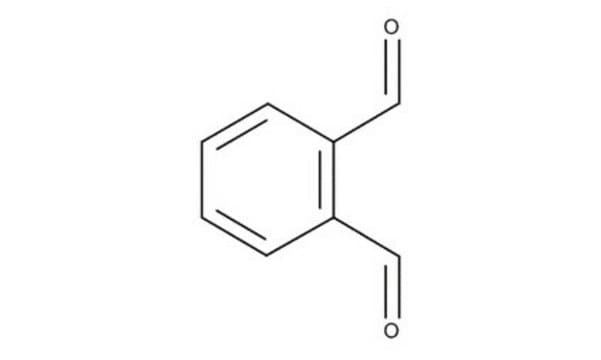Kluczowe dokumenty
79760
Phthaldialdehyde
for fluorescence, ≥99.0% (HPLC)
Synonim(y):
Benzene-1,2-dicarboxaldehyde, OPA, o-Phthalaldehyde, o-Phthalic dicarboxaldehyde, o-Phthalaldehyde, o-Phthalic dicarboxaldehyde
Wybierz wielkość
280,00 zł
Wybierz wielkość
About This Item
280,00 zł
Polecane produkty
klasa czystości
for fluorescence
Próba
≥99.0% (HPLC)
Formularz
solid
zanieczyszczenia
≤0.5% phthalic acid
mp
54-56 °C
fluorescencja
λex 334 nm; λem 455 nm (Thiol Adduct)
λex 340 nm; λem 450 nm in reaction buffer (with glycine)
przydatność
suitable for fluorescence
temp. przechowywania
2-8°C
ciąg SMILES
O=Cc1ccccc1C=O
InChI
1S/C8H6O2/c9-5-7-3-1-2-4-8(7)6-10/h1-6H
Klucz InChI
ZWLUXSQADUDCSB-UHFFFAOYSA-N
Szukasz podobnych produktów? Odwiedź Przewodnik dotyczący porównywania produktów
Opis ogólny
Zastosowanie
Działania biochem./fizjol.
Hasło ostrzegawcze
Danger
Zwroty wskazujące rodzaj zagrożenia
Zwroty wskazujące środki ostrożności
Klasyfikacja zagrożeń
Acute Tox. 3 Oral - Aquatic Acute 1 - Aquatic Chronic 1 - Eye Dam. 1 - Skin Corr. 1B - Skin Sens. 1 - STOT SE 3
Organy docelowe
Respiratory system
Kod klasy składowania
6.1A - Combustible acute toxic Cat. 1 and 2 / very toxic hazardous materials
Klasa zagrożenia wodnego (WGK)
WGK 3
Temperatura zapłonu (°F)
269.6 °F - closed cup
Temperatura zapłonu (°C)
132 °C - closed cup
Środki ochrony indywidualnej
Faceshields, Gloves, Goggles, type ABEK (EN14387) respirator filter
Wybierz jedną z najnowszych wersji:
Masz już ten produkt?
Dokumenty związane z niedawno zakupionymi produktami zostały zamieszczone w Bibliotece dokumentów.
Klienci oglądali również te produkty
Active Filters
Nasz zespół naukowców ma doświadczenie we wszystkich obszarach badań, w tym w naukach przyrodniczych, materiałoznawstwie, syntezie chemicznej, chromatografii, analityce i wielu innych dziedzinach.
Skontaktuj się z zespołem ds. pomocy technicznej







